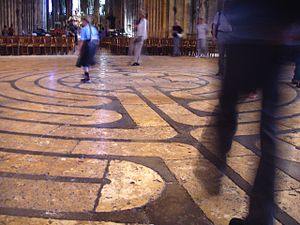Prayer labyrinth
The Prayer Labyrinth, also known as a meditation labyrinth, is one of the oldest contemplative and transformational tools known, having been used for many hundreds of years for prayer, ritual, initiation, and spiritual growth.
Origins
It is believed that the first labyrinth originated in Greek mythology, where it was an elaborate structure constructed for King Minos of Crete and designed by the legendary artificer Daedalus to hold the Minotaur, a creature that was half man and half bull and which was eventually killed by the Athenian hero Theseus. Theseus was aided by Ariadne, who provided him with a fateful thread to wind his way back again, a clue to the single path of the labyrinth. Labyrinths were also used as spiritual aides in ancient Egypt, Peru, and India.
The term labyrinth is often used interchangeably with maze, but modern scholars of the subject use a stricter definition. For them, a maze is a tour puzzle in the form of a complex branching passage, with choices of path and direction, while a single-path ("unicursal") labyrinth has only a single path to the centre. A labyrinth has an unambiguous through-route to the centre and back and is not designed to be difficult to navigate.
Christian use

As other pagan cultural practices, the Prayer Labyrinth was adopted by the Church across Europe during the medieval times, being often used as a means to meditate, pray and connect with God in a higher spiritual way. Numerous cathedrals in Europe have prayer labytinths embedded into their floors, with the Cathedral of Chartres (Notre-Dame de Chartres Cathedral), located about 80 km from Paris having one of the most famous prayer labyrinths in the world. Prayer Labyrinths were often viewed and modeled as a journey to Jerusalem and were even called Chemin de Jerusalem (Road of Jerusalem) serving as a spiritual pilgrimage for those who could not afford to travel to Jerusalem, the center of the world.
The widest accepted Prayer Labyrinth in the Church was the eleven-circuit labyrinth, which is more symbolic of Christ's cross with its four quadrants, and grace being symbolized by the never-ending path to the center and back, allowing the pilgrim to walk the path at his own pace, stop for prayer and meditation as needed.
By the 17th and 18th centuries however, Prayer Labyrinths have lost much of their spiritual meaning, with some clergy and other believers associated them with New Age and mystical practices.
With the practice of walking the Prayer Labyrinth becoming popular again in contemporary Christianity, many Christian denominations from across the theological spectrum are again adopting the practice of walking the Prayer Labyrinth, with some churches opening their labyrinths to any pilgrim in need of contemplation and prayer, pointing out that the Prayer Labyrinth is not a maze and rather has one path on which one cannot get lost, serving a powerful symbol of individual life journeys and pilgrimage in faith.
Walking the labyrinth
A Catholic writer describes their spiritual significance in this way: "The labyrinth is a universal symbol for the world, with its complications and difficulties, which we experience on our journey through life. The entry to the labyrinth is birth; the center is death and eternal life. In Christian terms, the thread that leads us through life is divine grace. Like any pilgrimage, the labyrinth represents the inner pilgrimage we are called to make to take us to the center of our being. It is but one example of how early Christians adapted pre-Christian allegories to Christian doctrine. The center of the labyrinth at Chartres actually once contained an engraved copper plate depicting the battle between Theseus and the Minotaur." In some Christian circles today the labyrinth continues to be used as an instrument to facilitate meditation, prayer, personal reflection, etc.
For example, when walking the Chartres style labyrinth the believer meanders through each of the four quadrants several times before reaching the goal. An expectation is created as to when the center will be reached. At the center is a rosette design which has a rich symbolic value including that of enlightenment.
